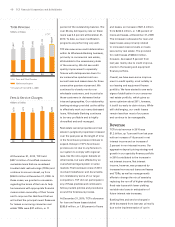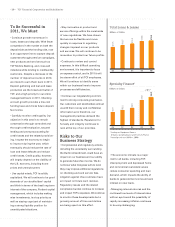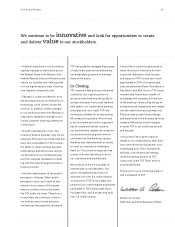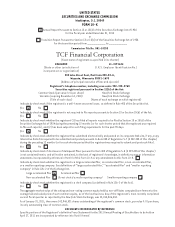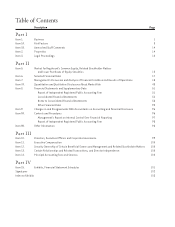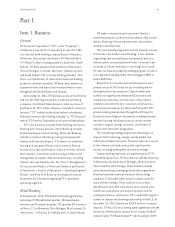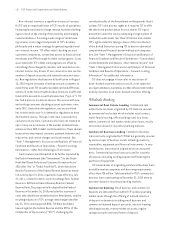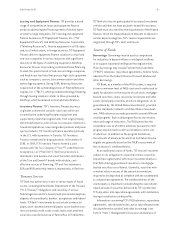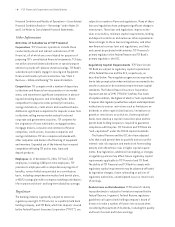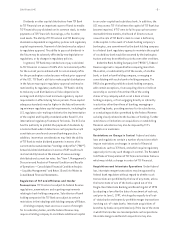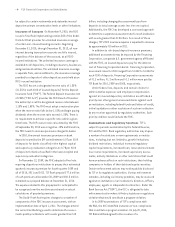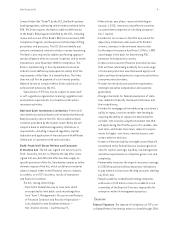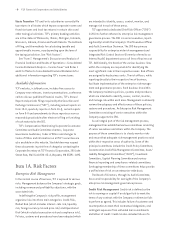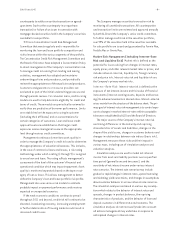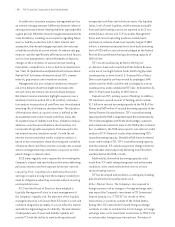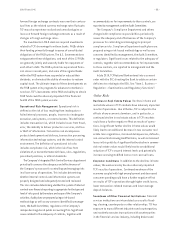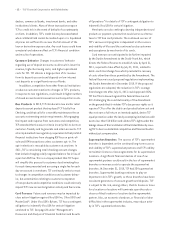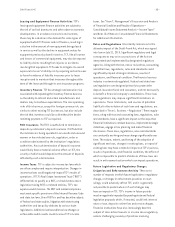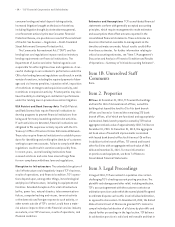TCF Bank 2010 Annual Report Download - page 20
Download and view the complete annual report
Please find page 20 of the 2010 TCF Bank annual report below. You can navigate through the pages in the report by either clicking on the pages listed below, or by using the keyword search tool below to find specific information within the annual report.• 4 • TCF Financial Corporation and Subsidiaries
Financial Condition and Results of Operations — Consolidated
Financial Condition Analysis — Borrowings” and in Notes 10
and 11 of Notes to Consolidated Financial Statements.
Other Information
Activities of Subsidiaries of TCF Financial
Corporation TCF’s business operations include those
conducted by direct and indirect subsidiaries of TCF
Financial, all of which are consolidated for purposes of
preparing TCF’s consolidated financial statements. TCF does
not utilize unconsolidated subsidiaries or special purpose
entities to provide off-balance sheet borrowings. TCF Bank’s
subsidiaries principally engage in Leasing and Equipment
Finance and Inventory Finance activities. See “Item 1.
Business — Wholesale Banking” for more information.
Competition TCF competes with a number of depository
institutions and financial service providers in its market
areas, and experiences significant competition in attract-
ing and retaining deposits and in lending funds. Direct
competition for deposits comes primarily from banks,
savings institutions, credit unions and investment banks.
Additional significant competition for deposits comes from
institutions selling money market mutual funds and
corporate and government securities. TCF competes for
the origination of loans with banks, mortgage bankers,
mortgage brokers, consumer and commercial finance
companies, credit unions, insurance companies and
savings institutions. TCF also competes nationwide with
other companies and banks in the financing of equipment
and inventory. Expanded use of the Internet has increased
competition affecting TCF and its loan, lease and
deposit products.
Employees As of December 31, 2010, TCF had 7,363
employees, including 2,385 part-time employees. TCF
provides its employees with a comprehensive program of
benefits, some of which are provided on a contributory
basis, including comprehensive medical and dental plans,
a 401(k) savings plan with a company matching contribution,
life insurance and short- and long-term disability coverage.
Regulation
The banking industry is generally subject to extensive
regulatory oversight. TCF Financial, as a publicly held bank
holding company, and TCF Bank, which has deposits insured
by the Federal Deposit Insurance Corporation (“FDIC”), are
subject to a number of laws and regulations. Many of these
laws and regulations have undergone significant change in
recent years. These laws and regulations impose restric-
tions on activities, minimum capital requirements, lending
and deposit restrictions and numerous other requirements.
Future changes to these laws and regulations, and other
new financial services laws and regulations, are likely
and cannot be predicted with certainty. TCF Financial’s
primary regulator is the Federal Reserve and TCF Bank’s
primary regulator is the OCC.
Regulatory Capital Requirements TCF Financial and
TCF Bank are subject to regulatory capital requirements
of the Federal Reserve and the OCC, respectively, as
described below. These regulatory agencies are required by
law to take prompt action when institutions are viewed to be
unsafe or unsound or do not meet certain minimum capital
standards. The Federal Deposit Insurance Corporation
Improvement Act of 1991 (“FDICIA”) defines five levels
of capital condition, the highest of which is “well-capitalized”.
It requires that regulatory authorities subject undercapitalized
institutions to various restrictions such as limitations on
dividends or other capital distributions, limitations on
growth or restrictions on activities. Undercapitalized
banks must develop a capital restoration plan and the
parent bank holding company is required to guarantee
compliance with the plan. TCF Financial and TCF Bank are
“well-capitalized” under the FDICIA capital standards.
The Federal Reserve and the OCC also have adopted
rules that could permit them to quantify and account for
interest-rate risk exposure and market risk from trading
activity and reflect these risks in higher capital require-
ments. New legislation, additional rulemaking, or changes
in regulatory policies may affect future regulatory capital
requirements applicable to TCF Financial and TCF Bank.
The ability of TCF Financial and TCF Bank to comply with
regulatory capital requirements may be adversely affected
by legislative changes, future rulemaking or policies of
regulatory authorities, unanticipated losses or lower levels
of earnings.
Restrictions on Distributions TCF Financial’s ability
to pay dividends is subject to limitations imposed by the
Federal Reserve. In general, Federal Reserve regulatory
guidelines call upon a bank holding company’s board of
directors to take a number of factors into account when
considering the payment of dividends, including the quality
and level of current and future earnings.


